
Dog agility
Encyclopedia
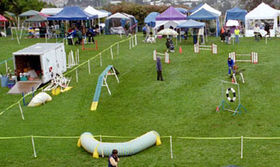
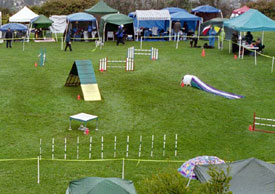
Dog
The domestic dog is a domesticated form of the gray wolf, a member of the Canidae family of the order Carnivora. The term is used for both feral and pet varieties. The dog may have been the first animal to be domesticated, and has been the most widely kept working, hunting, and companion animal in...
through an obstacle course
Obstacle course
An obstacle course is a series of challenging physical obstacles an individual or team must navigate usually while being timed. Obstacle courses can include running, climbing, jumping, crawling, swimming, and balancing elements with the aim of testing speed and endurance. Sometimes a course...
in a race for both time and accuracy. Dogs run off-leash
Leash
A leash is a rope or similar material attached to the neck or head of an animal for restraint or control...
with no food or toys as incentives, and the handler can touch neither dog nor obstacles. Consequently the handler's controls are limited to voice, movement, and various body signals, requiring exceptional training of the animal and coordination of the handler.
In its simplest form, an agility course consists of a set of standard obstacles laid out by a judge in a design of his or her own choosing in an area of a specified size. The surface may be of grass, dirt, or rubber. Depending on the type of competition, the obstacles may be marked with numbers indicating the order in which they must be completed.
Courses are complicated enough that a dog could not complete them correctly without human direction. In competition, the handler must assess the course, decide on handling strategies, and direct the dog through the course, with precision and speed equally important. Many strategies exist to compensate for the inherent difference in human and dog speeds and the strengths and weaknesses of the various dogs and handlers.
Competition basics
Because each course is different, handlers are allowed a short walk-through before the competition starts. During this time, all handlers competing in a particular class can walk or run around the course without their dogs, determining how they can best position themselves and guide their dogs to get the most accurate and rapid path around the numbered obstacles. The handler tends to run a path much different from the dog's path, so the handler can sometimes spend quite a bit of time planning for what is usually a quick run.The walk-through is critical for success because the course's path takes various turns, even U-turns or 270° turns, can cross back on itself, can use the same obstacle more than once, can have two obstacles so close to each other that the dog and handler must be able to clearly discriminate which to take, and can be arranged so that the handler must work with obstacles between himself and the dog, called layering, or at a great distance from the dog.
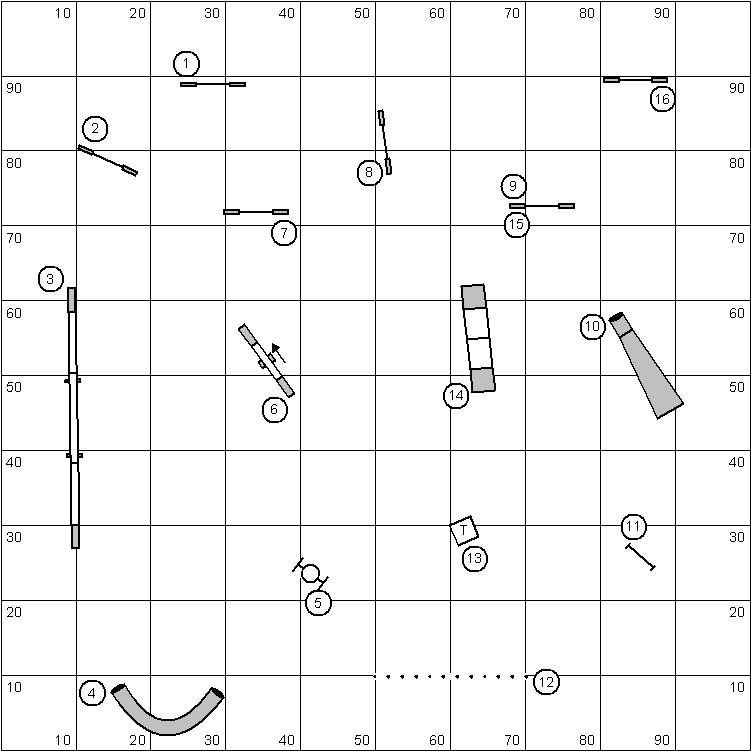
Each dog and handler team gets one opportunity together to attempt to complete the course successfully. The dog begins behind a starting line and, when instructed by his handler, proceeds around the course. The handler typically runs near the dog, directing the dog with spoken commands and with body language (the position of arms, shoulders, and feet).
Because speed counts as much as accuracy, especially at higher levels of competition, this all takes place at a full-out run on the dog's part and, in places, on the handler's part as well.
Scoring of runs is based on how many faults are incurred. Penalties can include not only course faults, such as knocking down a bar in a jump, but also time faults, which are the number of seconds over the calculated standard course time, which in turn is determined based on the competition level, the complexity of the course, and other factors.
Agility obstacles
The regulations of different organizations specify somewhat different rules and dimensions for the construction of obstacles. However, the basic form of most obstacles is the same wherever they are used. Obstacles include the following:Contact obstacles
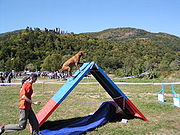 |
A-frame Two broad ramps, usually about 3 foot (0.9144 m) wide by 8 to 9 feet (2.7 m) long, hinged together and raised so that the hinged connection is between five and six-and-a-quarter feet above the ground (depending on the organization), roughly forming an A shape. The bottom 36 to 42 in (0.9144 to 1.1 m) of both sides of the A-frame are painted a bright color, usually yellow, forming the contact zone, onto which the dog must place at least one paw while ascending and descending. Most sanctioning organizations require that A-frames have low profile, narrow, horizontal slats all along their length to assist the dog's grip going up and down. Some organizations allow the top of the A-frame to be narrower than the bottom. |
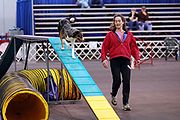 |
Dogwalk Three 8 to 12 ft (2.4 to 3.7 m) planks, 9 to 12 in (22.9 to 30.5 cm) wide, connected at the ends. The centre plank is raised to about 4 feet (1.2 m) above the ground, so that the two end planks form ramps leading up to and down from the center plank. This obstacle also has contact zones. Most sanctioning organizations also require slats on the dogwalk ramps. |
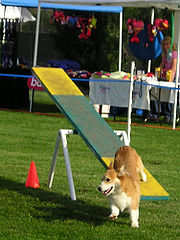 |
Teeter-totter (or seesaw Seesaw A seesaw is a long, narrow board pivoted in the middle so that, as one end goes up, the other goes down.-Mechanics:Mechanically a seesaw is a lever and fulcrum.... ) A 10 to 12 ft (3 to 3.7 m) plank pivoting on a fulcrum, much like a child's seesaw. It is constructed slightly off-balance so that the same end always returns to the ground. This is done either by placing the support slightly off-center or else weighting one end of the board. This obstacle also has contact zones. However, unlike the other contact obstacles, the teeter-totter does not have slats. The balance point and the weight of the plank must be such that even a tiny dog, such as a Chihuahua Chihuahua (dog) The ' is the smallest breed of dog and is so named for the state of Chihuahua in Mexico. Chihuahuas come in a wide variety of sizes, head shapes, colors and coat lengths.-History:... , can cause the high end of the teeter-totter to descend to the ground within a reasonable amount of time, specified by the sanctioning organization's rules (usually about 2 seconds). Smaller dogs get more time to run a course, and this is one reason why it can take them longer than it takes larger dogs. |
| Crossover A 4 feet (1.2 m) high, 3 by square platform, with ramps similar to those found on a dogwalk descending from the center of three or four of its sides. The dog must ascend the correct ramp and then descend the ramp indicated by the handler, possibly changing direction to do so. This obstacle has largely been discontinued due to its cumbersome size and danger of dogs falling off as they can not easily see where the narrow ramps meet the square platform center. No major agility organization in the United States currently allows the use of a crossover. The Kennel Club The Kennel Club The Kennel Club is a kennel club based in London and Aylesbury, United Kingdom.The Kennel Club registration system divides dogs into seven breed groups. The Kennel Club Groups are: Hound, Working, Terrier, Gundog, Pastoral, Utility and Toy... discontinued the use of this obstacle in January 2009, as well as the Agility Association of Canada, but other organizations may still allow it in competitions. |
Tunnels
 |
Tunnel A vinyl tube, 10 to 20 ft (3 to 6.1 m) long and about 2 feet (61 cm) in diameter, through which the dog runs. The tunnel is constructed of flexible vinyl and wire, such that it can be configured in a straight line, or in a variety of curves. |
 |
Collapsed Tunnel (or chute or cloth tunnel) A barrel-like cylinder with a tube of fabric attached around one end. The fabric extends about 8 to 12 ft (2.4 to 3.7 m) and lies closed until the dog runs into the open end of the chute and pushes his way out through the fabric tube. |
| |Other Tunnels UKC agility allows two additional tunnel types, the crawl tunnel and the hoop tunnel, that are not found in other agility organizations. CPE allowed an interconnected set of tunnels called a tunnel maze from 2004 though 2006, but discontinued the tunnel maze as of the 2007 rulebook. |
Jumps
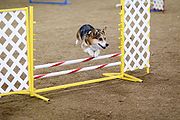
Stanchion
A stanchion is an upright bar or post, often providing support for some other object.* An architectural term applied to the upright iron bars in windows that pass through the eyes of the saddle bars or horizontal irons to steady the leadlight. A stanchion is an upright bar or post, often...
s or can have wings of various shapes, sizes, and colors.
Double and triple jump (or spread jump) : Two uprights supporting two or three horizontal bars spread forward or back from each other. The double can have parallel or ascending horizontal bars; the triple always has ascending bars. The spread between the horizontal bars is sometimes adjusted based on the height of the dog.
Panel jump: Instead of horizontal bars, the jump is a solid panel from the ground up to the jump height, constructed of several short panels that can be removed to adjust the height for different dog heights.
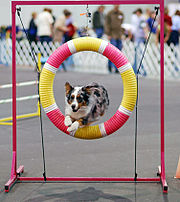
Tire jump: A torus
Torus
In geometry, a torus is a surface of revolution generated by revolving a circle in three dimensional space about an axis coplanar with the circle...
shape roughly the size of a tire
Tire
A tire or tyre is a ring-shaped covering that fits around a wheel rim to protect it and enable better vehicle performance by providing a flexible cushion that absorbs shock while keeping the wheel in close contact with the ground...
(18 inches (45.7 cm) to 24 inches (61 cm) inside diameter), suspended in a frame. The dog must jump through the opening of the "tire"; like other jumps, the height is adjusted for dogs of different sizes. The tire is usually wrapped with tape both for visibility and to cover any openings or uneven places in which the dog could catch.
Other hurdles: UKC agility allows a variety of hurdles not found in other agility organizations: bush hurdle, high hurdle, log hurdle, picket fence hurdle, rail fence hurdle, long hurdle, window hurdle, and water hurdle.
Miscellaneous
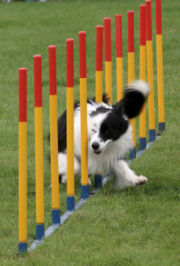
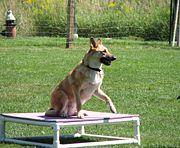
Weave poles: Similar to a slalom
Slalom skiing
Slalom is an alpine skiing discipline, involving skiing between poles spaced much closer together than in Giant Slalom, Super-G or Downhill, thereby causing quicker and shorter turns.- Origins :...
, this is a series of 5 to 12 upright poles, each about 3 foot (0.9144 m) tall and spaced about 24 inches (61 cm) apart (spacing for AKC was 21 inches (53.3 cm) until it was changed in January 2010. The extra three inches was to relieve stress on the dog's back.), through which the dog weaves. The dog must always enter with the first pole to his left, and must not skip poles. For many dogs, weave poles are one of the most difficult obstacles to master.
Other obstacles: UKC agility allows the following obstacles not found in other agility organizations: swing plank, sway bridge, and platform jump. NADAC also uses a hoop obstacle. A Hoopers course consists entirely of hoops, but hoops may be used in other courses as well.
Agility scoring and clean runs
Each organization has its own rules about what constitutes a fault, and whether one can earn a qualifying score with faulted runs. A completed run that passes the minimum defined standards for time, faults, points, etc., is referred to as a qualifying run and in some cases earns credit towards agility titles. A qualifying run is also referred to as a leg. A clean run or clear round is one with no faults.Different organizations place different values on faults, which can include the following:
| Time fault | Going over the maximum time allotted by the judge to complete a course (the standard course time (SCT)). |
|---|---|
| Missed contact | The dog failing to place a foot in the contact zone while performing a contact obstacle. Leaping from a contact obstacle a long way above the descending contact zone is sometimes called a flyoff. |
| Knocked or dropped bar | Displacing a bar (or panel) when going over a jump. |
| Weave pole fault | Entering the weave poles incorrectly (the dog must enter with the first pole on his left), skipping poles, or backweaving when attempting to correct missed poles. |
| Off course | Taking the wrong obstacle on a course in which the obstacles are numbered sequentially. |
| Refusal | The dog making an approach towards the correct obstacle, but then turning away or hesitating significantly before attempting the obstacle. |
| Runout | The dog running past the correct obstacle. |
| Handling | The handler deliberately—or, in some cases, accidentally—touching the dog or an obstacle. |
| Training in the ring | The handler deliberately taking an action that appears to be for the purpose of training the dog, rather than trying to run the course correctly, such as asking the dog to repeat an obstacle that he has already completed when the rules don't allow it. The penalty for this varies by organization: the handler may be excused from the ring, elimination may be scored but the handler is allowed to continue, the handler and dog may be allowed to complete their run but are given the maximum course time, and so on. Some organizations have no penalty for training in the ring. In general it is up to the judge to determine what is or isn't training in the ring. |
| Other faults | The dog biting the judge or the handler, the dog or handler exhibiting unsportsmanlike behavior, the dog eliminating in the ring, the dog leaving the ring and not coming back, the handler carrying toys or food into the ring, the dog running with his collar on (in organizations that prohibit collars being worn during a run), and so on. |
Competition classes
Given the available set of obstacles and possible faults, there are many permutations of games, or classes, that one can play on the agility field. A typical course is laid out within a 100 by area, with roughly 10 to 20 ft (3 to 6.1 m) between obstacles.Judges design their own courses (in NADAC, judges can do so or can select from previously designed courses) using the rules of the sanctioning organization. Each organization decides which classes are valid for achieving titles and how each must be performed, but there are many similarities.
Some of the common classes are
- Standard, Regular, or Agility: This is a numbered course consisting of (usually) at least one of each of the three primary contact obstacles (not including the crossover) plus jumps, tunnels, and weave poles of various flavors. A novice course might consist of as few as 15 obstacles; a higher-level course might have 22. The dog must negotiate the obstacles in the correct order within the standard course time (SCT).
- Jumpers or Jumping: This numbered course consists primarily of various types of jumps and, depending on the organization, also weave poles and tunnels. The dog must negotiate the obstacles in the correct order within the standard course time (SCT). The dogs achieve their fastest speed on these courses because there are no contact obstacles to slow them down.
- Gamblers, Jackpot, or Joker: An unnumbered course. The game typically consists of two parts, an opening period and the closing period, also known as the gamble, joker, or jackpot. In the opening period, the dog has a certain amount of time in which to do whatever obstacles the handler deems appropriate and accrues points based on the obstacles completed. At the end of the allocated time for the opening period, a whistle blows. At that point, the gamble begins. The dog has a certain small amount of time (about 15 seconds) in which to complete a sequence of obstacles designated by the judge ahead of time. The challenge is that there is a line on the ground past which the handler must not step, typically paralleling the gamble obstacles, from 10 to 20 ft (3 to 6.1 m) away depending on the level of competition. The handler must choose an opening sequence that flows comfortably for the individual dog's skills and experience. The sequence must also be planned so that, when the whistle blows, the dog is in a good position to immediately begin the gamble. The greatest challenge is the distance handling – getting the dog to move or even turn away from you.
- Snooker: Loosely based on the billiard game of SnookerSnookerSnooker is a cue sport that is played on a green baize-covered table with pockets in each of the four corners and in the middle of each of the long side cushions. A regular table is . It is played using a cue and snooker balls: one white , 15 worth one point each, and six balls of different :...
. The course has at least three red jumps, each numbered 1, and six other obstacles numbered 2 through 7. The dog accumulates points based on the obstacle's number. This also has two parts, an opening sequence and a closing sequence. In the opening sequence, the dog must complete a 1, then any obstacle numbered 2 to 7, a different 1 and any 2 to 7 obstacle (including the one already performed), and yet another different 1 and another 2-7 obstacle. For example, the dog could perform the red on the left for 1 point, the 7-point obstacle, the red in the middle for 1 point and then the 7-pointer again, then the red on the far side of the course and the 7-pointer one more time, for a total of 24 points in the opening. After successfully completing this, the dog must complete the obstacles 2-7, in order, for an additional possible 27 points. Failure to follow these rules exactly (such as knocking a bar or taking 2 reds in a row) results in the dog and handler being whistled off the course.- Strategy and entertainment value: The dogs might have to negotiate between other obstacles without taking them or make a difficult entry to the obstacle, often combined with a longer distance between the reds and the 7 so that it consumes more time to do the higher-point obstacle in the opening.
- Power & Speed: The course consists of two sections. The first is an untimed "Power" section, which features the contact equipment and any of the following at the discretion of the judge setting the course: weaves, table, a-frame, spread jump, long jump. If this section is negotiated without accruing any faults, the dog and handler may go on to the "Speed" section, which consists of a timed jumping course.
- Juniors: USDAA defines this class for handlers aged 18 or younger, who may compete with their dogs at four levels, beginner, elementary, intermediate, and senior. Each level gets progressively harder and gains more obstacles. The competitors earn medals or bronze, silver, or gold or rosettes of blue, red, yellow, or white.
- Team, Pairs, or Relay: Two or three dog-and-handler teams each execute a portion of a Standard agility course, with the handlers exchanging a baton between sections.
- Variations and combinations of the preceding, such as AKC's Fifteen and Send TimeFifteen and Send TimeFifteen and send time is a relatively new dog agility competition offered by the American Kennel Club. FAST can be thought of as a free-style agility competition similar to the Gambler, Joker, or Jackpot in other venues....
(FAST) class.
Fairness among dogs
Although each organization has its own rules, all divide dogs into smaller groups that are close to each other in size and experience for purposes of calculating winners. This means that there will be winners in each group for each class (or game) over the course of a trial.Dogs are measured in height at the peak of their withers
Withers
The withers is the ridge between the shoulder blades of a four-legged animal. In many species it is the tallest point of the body, and in horses and dogs it is the standard place to measure the animal's height .-Horses:The withers in horses are formed by the dorsal spinal processes of roughly the...
(shoulders). They are then divided into height groups; for example, dogs measuring between 12 and 16 in (30.5 and 40.6 cm) might compete together with the jumps set at a height of 16 inches (40.6 cm). This ensures that dogs who might have an advantage on a particular course because of their size (larger or smaller) keep the advantage to a minimum.
Dogs are further divided into their experience levels. So, for example, there may be competitions for 12 inches (30.5 cm) Novice dogs, 12 inches (30.5 cm) Intermediate dogs, and 12 inches (30.5 cm) Masters dogs. Dogs typically have to have certain numbers of successes at lower levels before they can move up to compete with more advanced dogs. Some organizations allow beginner dogs to run on-leash in some situations.
Some organizations divide dogs into additional optional categories because the dogs are older (usually over seven years), have junior handlers (usually under 18), need to jump at a lower height than the regular standard, or the like. For example, a veterans class for older dogs might allow the dogs to jump at a height lower than the standard height and to have more time to complete the course. Otherwise, dogs are not separated by age; they must only be of at least a specified minimum age to compete.
Dogs also are not separated by breed
Dog breed
Dog breeds are groups of closely related and visibly similar domestic dogs, which are all of the subspecies Canis lupus familiaris, having characteristic traits that are selected and maintained by humans, bred from a known foundation stock....
in agility competitions. Some organizations require that dogs entering its competitions must be purebred
Purebred
Purebreds, also called purebreeds, are cultivated varieties or cultivars of an animal species, achieved through the process of selective breeding...
, but many organizations allow any sound, able-bodied dog, whether purebred or mixed-breed
Mixed-breed dog
A mixed-breed dog, also known as a mutt or mongrel, is a dog whose ancestry is generally unknown and that has characteristics of two or more types of breeds. A mixed-breed may be a cross-breed dog, a random-bred dog, or a descendant of feral or pariah dog populations...
.
History of dog agility
The history of dog agilityHistory of dog agility
The history of dog agility can be traced to a demonstration in the late 1970s in the United Kingdom. It has since spread rapidly around the world, with major competitions held worldwide.- History in the United Kingdom :...
can be traced to a demonstration at the Crufts Dog Show in the late 1970s in the United Kingdom. Dogs were run around a course designed similar to horse jumping courses during intermission as a way to entertain the audience. It has since spread rapidly around the world, with major competitions held worldwide.
Agility worldwide
Dog agility is an international dog sport with many different sanctioning organizations and competitions worldwide.International championships
Some competitions invite qualified entrants from multiple countries, thereby making them international championships. Examples include:- Fédération Cynologique InternationaleFédération Cynologique InternationaleFédération Cynologique Internationale is an international federation of kennel clubs based in Thuin, Belgium. The English language translation, World Canine Organisation, is not often used.Its goals are described in Article 2 of their regulations:...
Agility World Championships, the oldest and best-known, always (so far) held in Europe. The event was held as a European championship until 1995, then a world championship from 1996, and is restricted to registered pedigree dogs only. The FCI has more than 80 member countries (via each country's kennel clubKennel clubA kennel club is an organization for canine affairs that concerns itself with the breeding, showing and promotion of more than one breed of dog...
), over 30 of which typically take part in the FCI World Championships. The British, American and Canadian kennel clubs are not FCI members, but their teams are allowed to participate by special invitation. - The International Mix & Breed Championship in Agility (IMCA), first held in Italy in 2000 as a response to the FCI pedigree-only championships. The competition is held annually with about 18 countries participating, including teams from outside Europe. Now open to any breed or mixed-breed dogMixed-breed dogA mixed-breed dog, also known as a mutt or mongrel, is a dog whose ancestry is generally unknown and that has characteristics of two or more types of breeds. A mixed-breed may be a cross-breed dog, a random-bred dog, or a descendant of feral or pariah dog populations...
regardless of origins, and in Europe considered to be the main international rival to the FCI championships.
Since the 2002 IMCA (Gyula, Hungary), this championship is organised together with the ParAgility World Cup for disabled competitors.
- The International Federation of Cynological Sports (IFCS), has since 2002 organized a biannual world agility championship open to any breed or mixed-breed dogMixed-breed dogA mixed-breed dog, also known as a mutt or mongrel, is a dog whose ancestry is generally unknown and that has characteristics of two or more types of breeds. A mixed-breed may be a cross-breed dog, a random-bred dog, or a descendant of feral or pariah dog populations...
regardless of pedigree. English-speaking member or associate member countries include the United States (via the United States Dog Agility Association), the United Kingdom (via UK Agility), Canada (via the Agility Association of Canada), and Australia (via the Agility Dog Association of Australia). Ten countries participated in the event in 2006. - The Cynosport World Games, officially named in 2003, as the consolidated venue for USDAA's three tournament series - Grand Prix of Dog Agility, $10,000 Dog Agility Steeplechase and Dog Agility Masters Three-Dog Team Championship — and exhibitions and competitions in other popular canine sports. USDAA tournaments were opened to invited overseas participants for the first time in 2001, which led to establishment of USDAA affiliates in other countries where qualifying events are now held each year. Prior to 2001, USDAA qualifying events were limited to Canada, Mexico, Puerto Rico and the United States. The Cynosport World Games in 2006 attracted some 1,000 competitors in dog agility from twelve countries, and also now includes world championship events in flyball and flying disc. Participants from other countries may still apply for participation by invitation if USDAA qualifying events are not held in their country or region.
- The European Open. An informal annual championships since its foundation in 2002, open to all dogs regardless of origins. It rotates around a small number of countries in central Europe, though attracting competitors from all over Europe, with 25 countries due to participate in the 2006 event. From 2007, the competition will be held under Fédération Cynologique Internationale regulations, with a view to developing it into a 'World Open'. In years when the World Dog ShowWorld Dog ShowThe World Dog Show is a Fédération Cynologique Internationale-sanctioned international dog show, held yearly since 1971. The World Show includes agility, obedience, junior handler, conformation, and other events and demonstrations. International championships for many events are awarded at the...
is held in Europe, the European Open will be held at the World Show and not separately.
Training
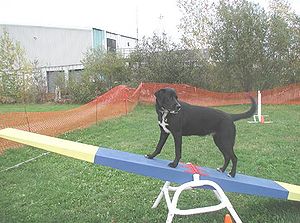
Introducing a new dog to the agility obstacles varies in response. Each individual dog learns at his own pace; confident dogs may charge over equipment with little encouragement, while more timid dogs may take weeks to overcome their hesitations with much encouragement. Both scenarios present their own challenges; dogs may be overconfident and sloppy to the point where they have a serious accident, so self control must be taught. Timid dogs need extra support to boost their confidence. Given the right encouragement, a timid dog can gain confidence through learning the sport itself. The size of the dog can also have an effect on training obstacles, particularly with the chute, in which smaller dogs are prone to getting trapped and tangled inside. Great effort is taken in general to see that the dog is always safe and has a good experience in training for agility so that they do not fear the obstacles, and instead perform them willingly and with enthusiasm.
The teeter-totter (or see-saw) and the weave poles are typically the most challenging obstacles to teach to any dog. Many dogs are wary of the see-saw's movement, and the weave poles involve a behavior that does not occur naturally to the dog. Contact obstacles in general are challenging to train in a manner that ensures that the dog touches the contact zone without sacrificing speed. Whether for competition or recreation, the most important skill for an agility team to learn is how to work together quickly, efficiently, and safely. Dogs vary greatly in their speed and accuracy of completing a course, as well as in their preferences for obstacles; therefore, the handler must adjust their handling style to suit and support the dog.
Training techniques for each piece of equipment varies. For example, the techniques for training the weave poles include using offset poles that gradually move more in line with each other; using poles that tilt outward from the base and gradually become upright; using wires or gates around the poles forcing the dog into the desired path; putting a hand in the dog's collar and guiding the dog through while leading with an incentive; teaching the dog to run full speed between two poles and gradually increasing the angle of approach and number of poles; et cetera.
Agility can be trained independently (for instance at home) or with an instructor or club that offers classes. Seasoned handlers and competitors, in particular, may choose to train independently, as structured classes are commonly geared towards novices. Seasoned handlers often instead look to seminars and workshops that teach advanced handling techniques, and then practice on their own.
Common reasons for joining an agility class include:
- Access to agility equipment, especially the larger contact obstacles, which can be expensive, difficult to build, and require a lot of space to use.
- Seeking the guidance and expertise of more experienced handlers.
- Enjoying the social venue that many classes provide.
- Training in a more distracting environment, which is helpful in preparation for competition.
In addition to the technical and educational training, physical training must also be done. At the very least, the dog must be fit enough to run and jump without causing stress or injury to its body. The handler can also benefit from being physically fit, but with some handling styles it is not necessary to keep up with the dog (nor is it possible with very fast dogs). Being able to handle a dog from a distance allows mobility-impaired handlers to participate in the sport en par with mobile handlers.
Competition process
Competitions (also called trials or matches or shows) are usually hosted by a specific local club. The club might be devoted solely to dog agility, or it might be primarily a breed clubBreed club (dog)
A dog breed club is an association or club of fanciers of a single, specific breed of dog.Breed clubs define the breed with which the club is associated in a document called a breed standard, although there may be multiple breed clubs for the same breed, each defining the breed in a somewhat...
that wants to promote the working abilities of its breed, or it might be a club that hosts many types of dog sports. The club contracts with judges who are licensed by the sanctioning organization and applies to the organization for permission to hold a trial on a specific date or weekend; most trials are two-day weekend events.
Key trial jobs
The club designates a member to be the chairperson or show manager, who is responsible for ensuring that the trial takes place, and another member to be the secretary, who is responsible for providing competitors with the show premium or schedule--a document that describes the specific competition, summarizes the rules, describes the trial site, and includes an entry form—receiving completed entry forms, sending out running orders, producing running-order lists for the day of competition, and compiling the results from the trial to send to the sanctioning organization.The designated chief ring steward or ring manager is responsible for finding and assigning workers, almost always volunteers, to perform the myriad tasks involved in putting on a trial. For example, if electronic timing is not being used, each class needs a timer, who ensures that the dog's running time is recorded, a scribe, who records the judge's calls as a dog runs the class, and pole setters (or ring stewards), who ensure that jump bars are reset when they are knocked off and change jump heights for dogs of different sizes.
Competition locations
Agility competitions require considerable space. Each ring is usually at least 100 feet (30.5 m) on each side, though exact dimensions vary according to the organisations. Competitions can have anything from one up to more than a dozen rings. The ground must be level and, ideally, grassy, although other surfaces are used.In addition, competitors need space to set up quarters for their dogs and gear; when space permits, competitors often bring pop-up canopies
Canopy (building)
A canopy is an overhead roof or else a structure over which a fabric or metal covering is attached, able to provide shade or shelter. A canopy can also be a tent, generally without a floor....
or screenroom awning tents for shade. Dogs, when not competing, are usually left to rest in exercise pens, crate
Crate (pet)
A dog crate is a metal, wire, plastic, or fabric enclosure with a door in which a dog may be kept for security or transportation. For best results in using crates, crate training is recommended. are designed to replicate a dog's natural den and as such can provide them with a place of refuge at...
s, or dog tents
Crate (pet)
A dog crate is a metal, wire, plastic, or fabric enclosure with a door in which a dog may be kept for security or transportation. For best results in using crates, crate training is recommended. are designed to replicate a dog's natural den and as such can provide them with a place of refuge at...
familiar and enclosed environments in which they can relax and recover between runs. Handlers also bring reflective cloths to protect their dogs from sun exposure and to calm them down (by covering their crates with the cloths). There also needs to be space for many handlers with dogs on leashes to move freely around the rings without crowding, and space for warming up, exercising, and pottying dogs. Adjacent to the site, parking must be available for all competitors. At weekend or weeklong shows that offer camping, space needs to be provided both for competitors' caravans and tents, and for the small fenced enclosures or gardens that they set up around them.
In heavily populated areas, therefore, it is uncommon to find real estate inexpensive enough to devote entirely to agility, so sites are usually rented for the weekend. Even in more rural areas, agility-only sites are uncommon. Popular locations include fairground
Funfair
A funfair or simply "fair" is a small to medium sized travelling show primarily composed of stalls and other amusements. Larger fairs such as the permanent fairs of cities and seaside resorts might be called a fairground, although technically this should refer to the land where a fair is...
s, large park
Park
A park is a protected area, in its natural or semi-natural state, or planted, and set aside for human recreation and enjoyment, or for the protection of wildlife or natural habitats. It may consist of rocks, soil, water, flora and fauna and grass areas. Many parks are legally protected by...
s, covered horse-riding arenas, and in cold-winter areas, large, empty warehouses in which mats or carpet can be laid.
Course design
Before the trial, each judge designs the courses that he or she will judge at the competition. The sanctioning organization usually reviews and approves the courses to ensure that they meet the organization's guidelines. Guidelines include such issues as how far apart obstacles must be, how many turns are allowed (or required) on a course, which obstacles and how many of each must appear on the course, and so on. The rules vary by level of competition and by organization.Building a course and calculating times
Before each class, or the evening before the first class, course builders use course maps provided by the judges to place equipment on the course. The chief course builder is usually an experienced competitor who understands what equipment is legal, how it must be configured, how each must be aligned compared to other obstacles, and can direct several course-building volunteers to efficiently move the equipment into place. To make the job easier, courses are often marked in some way to correspond to a grid: for example, if course maps are printed on a grid of 10-foot-by-10-foot squares, the posts that hold the ring ropes marking the course's four sides are often set 10 feet apart.When the course builders finish, the judge walks through the course and double-checks that the obstacles are legal, that they are placed where the judge intended, and that there are no unintended hazards on the course (such as potholes, uneven ground, or mud puddles) around which the course must be adjusted. For many classes, the judge then measures the path through the course to determine the optimal running distance of a typical dog. The judge uses that measurement with a speed requirement determined by the rules to calculate the standard course time, the time under which dogs must complete the course to avoid time faults. For example, if the course is 150 yards (or meters) long, and the rules state that dogs must run the course at a rate of at least 3 yards (or meters) per second, the standard course time would be 50 seconds. Other organizations, though, leave the decision on course time to the judge's discretion
Running a course and determining results
The judge often holds a briefing for competitors before each class, to review the rules and explain specific requirements for a particular course. For Standard courses for experienced competitors, the judge's briefing is often minimal or dispensed with altogether. For novice handlers in classes with complex rules, the briefings can be much longer.The competitors then walk the course (as described earlier). When the walk-through ends, the gate steward or caller ensures that dogs enter the ring in the running order previously determined by the trial secretary and manages changes to the running order for handlers who might have conflicts with other rings of competition. As each dog and handler team runs the course, the dog is timed either by a person with a stopwatch or with an electronic timer, and the scribe writes the judge's calls and the dog's final time on a scribe sheet or ticket, which is then taken to the score table for recording.
At the score table, scorekeepers compile the results in a variety of ways. Some organizations require or encourage computerized scorekeeping; others require certain types of manual score sheets to be filled out. When all the dogs in a given height group, level, and class have run, the score table compares run times, faults, and any other requirements to determine placements (and, for classes that provide qualifying points towards titles, which dogs earned qualifying scores).
Each ring might run several classes during a day of competition, requiring multiple course builds, walk throughs, briefings, and so on.
Awards and Titles

Award ribbon
A ribbon is an award made from ribbon and presented to mark an achievement. Such ribbons usually have a pin or other fastener with which the award can be attached to clothing, walls, or other surfaces....
s, rosette
Rosette (decoration)
A rosette is a small, circular device that is presented with a medal. The rosettes are primarily for situations where wearing the medal is deemed inappropriate. Rosettes are issued in nations such as France, Italy and Japan...
s, commemorative plaque
Commemorative plaque
A commemorative plaque, or simply plaque, is a plate of metal, ceramic, stone, wood, or other material, typically attached to a wall, stone, or other vertical surface, and bearing text in memory of an important figure or event...
s, trophies
Trophy
A trophy is a reward for a specific achievement, and serves as recognition or evidence of merit. Trophies are most often awarded for sporting events, from youth sports to professional level athletics...
, medal
Medal
A medal, or medallion, is generally a circular object that has been sculpted, molded, cast, struck, stamped, or some way rendered with an insignia, portrait, or other artistic rendering. A medal may be awarded to a person or organization as a form of recognition for athletic, military, scientific,...
s, or pin
Award pin
An award pin is a small object, usually made from metal or plastic, with a pin on the back, presented as an award of achievement or a mark of appreciation. They are worn on clothes such as jackets, shirts or hats....
s. Some clubs award high-in-trial awards, calculated in various ways, or other special awards for the trial. Dogs who complete their final qualifying scores to become agility champions are often presented with special awards.
Many Kennel Clubs also award titles to those who manage to qualify enough times in a particular level. Most clubs require three qualifying scores in any level to get the corresponding title, however, other clubs may require more or less.
See also
- Dog sports
- Fifteen and Send TimeFifteen and Send TimeFifteen and send time is a relatively new dog agility competition offered by the American Kennel Club. FAST can be thought of as a free-style agility competition similar to the Gambler, Joker, or Jackpot in other venues....
- Championship (dog)Championship (dog)Championships are awarded to dogs who have passed through a process of selection at dog shows. Traditionally, a championship was received at a conformation show, but championships are now offered for dogs who have attained a high degree of perfection in other dog sports as well.-The conformation...
- Show JumpingShow jumpingShow jumping, also known as "stadium jumping," "open jumping," or "jumpers," is a member of a family of English riding equestrian events that also includes dressage, eventing, hunters, and equitation. Jumping classes commonly are seen at horse shows throughout the world, including the Olympics...
- Rat agilityRat agilityRat agility is a sport for pet rats. It basically uses scaled down versions of the obstacles used for dog agility. The sport originated in Sweden and can trace its origin back to table runs in the 1980s.Rat agility is performed in two classes...
- Dock jumpingDock jumpingDock jumping also known as dock diving is a dog sport in which dogs compete in jumping for distance or height from a dock into a body of water.There are dock jumping events in the United States and other countries such as United Kingdom,...

